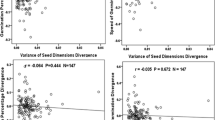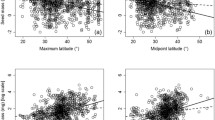Abstract
The importance of phylogenetic effects in controlling seed size variation at the macroevolutionary levels was examined using species of a well-defined, monophyletic family, the Leguminosae. A nested ANOVA was used to separate variance components at the various taxonomic levels such as subfamily, genus, and subgenus. Statistical significance was found at most of the taxonomic levels examined, which suggests that phylogeny as shown by the accepted taxonomy of the family, exerted a substantial influence over seed size variation. Thus, there appears to be a characteristic mean seed size for each genus and subgenus. The overall positive correlation between plant height and seed size was interpreted as a scaling of seed size to plant height. When the effect of plant height was controlled, the amount of variance changed to some extent across taxonomic levels, though resulting in no change in statistical significance at various taxonomic levels. This results indicate that phylogenetic effects in seed size variation among congeneric or consubgeneric groupings were largely independent of allometric effects. The patterns of variance components and intraclass correlation coefficients for seed size differed to some extent among subfamilies. The difference in those patterns among taxa will reflect evolutionary change more closely with larger sample sizes. A simple inverse relationship between seed size and number per fruit among related legume species was difficult to generalize. This was perhaps due to phylogenetic constraints on seed size and/or seed number (or ovule number). These results demonstrate that phylogeny and plant height affect seed size variation among related species.
Similar content being viewed by others
References
Ali S. I. (1968) Correlation between seed weight and breeding system in closely related amphimitic taxa. Nature 218: 492–493.
Armstrong D. P., Westoby M. (1993) Seedlings from large seeds tolerate defoliation better: a test using phylogenetically independent contrasts. Ecology 74: 1092–1100.
Arroyo M. T. K. (1981) Breeding systems and pollination biology in Leguminosae. In: Polhill R. M., Raven P. H. (eds.) Advances in legume systematics. Royal Bot. Gard. Kew, pp. 723–769.
Baker H. G. (1972) Seed weight in relation to environmental conditions in California. Ecology 53: 997–1010.
Baker H. G., Baker I. (1981) Chemical constituents of nectar in relation to pollination mechanisms and phylogeny. In: Nitecki M. H. (ed.) Biochemical aspects of evolutionary biology. University of Chicago Press, Chicago, pp. 131–171.
Barneby R. C. (1964) Atlas of North AmericanAstragalus. Mem. N. Y. Bot. Gard. vol. 13, Part 1 and 2.
Bell G. (1989) A comparative method. Amer. Nat. 133: 553–571.
Corner E. J. H. (1967) On thinking big. Phytomorph. 17: 24–28.
Felsenstein J. (1985) Phylogenies and the comparative method. Amer. Nat. 125: 1–15.
Foster S. A., Janson C. H. (1985) The relationship between seed size and establishment conditions in tropical woody plants. Ecology 66: 773–780.
Gould S. J., Lewontin R. C. (1979) The spandrels of San Marco and the Panglossian paradigm: a critique of the adaptationist programme. Proc. R. Soc. London Series B 205: 581–598.
Haig D., Westoby M. (1991) Seed size, pollination costs and angiosperm success. Evol. Ecol. 5: 231–247.
Harper J. L., Lovell P. H., Moore K. G. (1970) The shapes and sizes of seeds. Ann. Rev. Ecol. Syst. 1: 327–356.
Harvey P. H., Mace G. M. (1982) Comparisons between taxa and adaptive trends: problems of methodology. In: King's College Sociobiology Group (eds.) Current Problems in Sociobiology. Cambridge University Press, Cambridge, pp. 343–361.
Hodgson J. G., Mackey J. M. L. (1986) The ecological specialization of dicotyledonous families within a local flora: some factors constraining optimization of seed size and their possible evolutionary significance. New Phytol. 104: 497–515.
Irwin H. S., Barneby R. C. (1982) The American Cassiinae. A Synoptical Revision of Leguminosae Tribe Cassieae Substribe Cassiinae in the New World. Mem. N. Y. Bot. Gard. vol. 35.
Janzen D. H. (1969) Seed-eaters versus seed size, number, toxicity and dispersal. Evolution 23: 1–27.
Kelly C. K. (1995) Seed size in tropical trees: a comparative study of factors affecting seed size in Peruvian angiosperms. Oecologia 102: 377–388.
Kelly C. K., Purvis A. (1993) Seed size and establishment conditions in tropical trees. Oecologia 94: 356–360.
Kress W. J. (1981) Sibling competition and evolution of pollen unit, ovule number, and pollen vector in angiosperms. Syst. Bot. 6: 101–112.
Leishman M. R., Westoby M., Jurado E. (1995) Correlates of seed size variation: a comparison among five temperate floras. J. Ecol. 83: 517–530.
Leishman M. R., Westoby M. (1994) Hypotheses on seed size: tests using the semiarid flora of western New South Wales, Australia. Amer. Nat. 143: 890–906.
Lessios H. A. (1990) Adaptation and phylogeny as determinants of egg size in echinoderms from the two sides of the Isthmus of Panama. Amer. Nat. 135: 1–13.
Matlack G. R. (1987) Diaspore size, shape, and fall behavior in wind-dispersed plant species. Amer. J. Bot. 74: 1150–1160.
Mazer S. J. (1987) Maternal investment and male reproductive success in angiosperms: parent-offspring conflict or sexual selection? Biol. Soc. Linn. Soc. 30: 115–133.
Muller J. (1984) Significance of fossil pollen for angiosperm history. Ann. Missouri Bot. Gard. 71: 419–443.
Nielson I., Baretta-Kuipers T., Guinet P. (1984) The genusArchidendron (Leguminosae — Mimosoideae). Opera Botanica vol. 76.
O'Dowd D. J., Gill A. M. (1986) Seed dispersal syndromes in Australian Acacia. In: Murray D. R. (ed.) Seed dispersal. Academic Press, New York, pp. 87–121.
Pagel M. D., Harvey P. H. (1988) Recent developments in the analysis of comparative data. Q. Rev. Biol. 63: 413–440.
Peat H. J., Fitter A. H. (1994) Comparative analyses of ecological characteristics of British angiosperms. Biol. Rev. 69: 95–115.
Pedhauzer E. J. (1982) Multiple regression in behavioral research, 2nd edn. Holt, Rinehart and Winston, New York.
Pedley L. (1978) A revision ofAcacia Mill. in Queensland. Part 1. Austrobaileya 1: 75–234.
Pedley L. (1979) A revision ofAcacia Mill. in Queensland. Part 2. Austrobaileya 1: 235–337.
Polhill R. M. (1982)Crotalaria in Africa and Madagascar. A. A. Balkema, Rotterdam.
Polhill R. M., Raven P. H., Stirton C. H. (1981) Evolution and systematics of the Leguminosae. In: Polhill R. M., Raven P. H. (eds.) Advances in legume systematics. Royal Bot. Gard. Kew, pp. 1–26.
Primack R. B. (1987) Relationships among flowers, fruits, and seeds. Ann. Rev. Ecol. Syst. 18: 409–430.
Queller D. C. (1983) Kin selection and conflict in seed maturation. J. Theor. Biol. 100: 153–172.
Raven P. H., Polhill R. M. (1981) Biogeography of the Leguminosae. In: Polhill R. M., Raven P. H. (eds.) Advances in legume systematics. Royal Bot. Gard. Kew, pp. 27–34.
Salisbury E. J. (1942) The reproductive capacity of plants. G. Bell and Sons, London.
SAS, 1985: SAS User's Guide: Statistics. SAS Institute, Cary.
Silvertown J. W. (1981) Seed size, life span, and germination date as coadapted features of plant life history. Amer. Nat. 118: 860–864.
Silvertown J. W. (1989) The paradox of seed size and adaptation. Trends Ecol. Evol. 4: 24–26.
Small E. (1989) The evolution of genera in the Leguminosae. Ann. Missouri Bot. Gard. Monogr. Syst. Bot. 29: 467–486.
Smith C. S., Fretwell S. D. (1974) The optimal balance between size and number of offspring. Amer. Nat. 108: 499–506.
Sokal R. R., Rohlf F. J. (1981) Biometry, 2nd edn. W. H. Freeman and Company, New York.
Thompson K., Rabinowitz D. (1989) Do big plants have big seeds? Amer. Nat. 133: 722–728.
Uma Shaanker R. U., Ganashaiah K. N., Bawa K. S. (1988) Parent-offspring conflict, sibling rivalry, and brood size patterns in plants. Ann. Rev. Ecol. Syst. 19: 177–205.
van der Pijl L. (1956) Classification of the leguminous fruits according to their ecological and morphological properties. Proc. Nederl. Akad. Wet. C. 59: 301–313.
van der Pijl L. (1982) Principles of dispersal in higher plants, 3rd edn. Springer, New York.
Wanntorp H. E. (1983) Historical constraints in adaptation theory: traits and non-traits. Oikos 41: 157–160.
Webb C. J. (1984) Constraints on the evolution of plant breeding systems and their relevance to systematics. In: Grant W. F. (ed.) Plant biosystematics. Academic Press, Toronto, pp. 249–270.
Wright S. J., Calderon O. (1995) Phylogenetic patterns among tropical flowring phenologies. J. Ecol. 83: 937–948.
Wunderlin R. P. (1983a) Revision of the arborescentBauhinias (Fabaceae: Caesalpinioideae: Cercideae) native to Middle America. Ann. Missouri Bot. Gard. 70: 95–127.
Wunderlin R. P. (1983b) Three new species ofBauhinia (Fabaceae) from Ecuador. Brittonia 35: 335–340.
Zar J. H. (1984) Biostatistical analysis, 2nd edn. Prentice Hall, Englewood Cliffs, NJ.
Author information
Authors and Affiliations
Rights and permissions
About this article
Cite this article
Kang, H., Primack, R.B. Evolutionary change in seed size among some legume species: The effects of phylogeny. Pl Syst Evol 219, 151–164 (1999). https://doi.org/10.1007/BF00985576
Received:
Accepted:
Issue Date:
DOI: https://doi.org/10.1007/BF00985576




